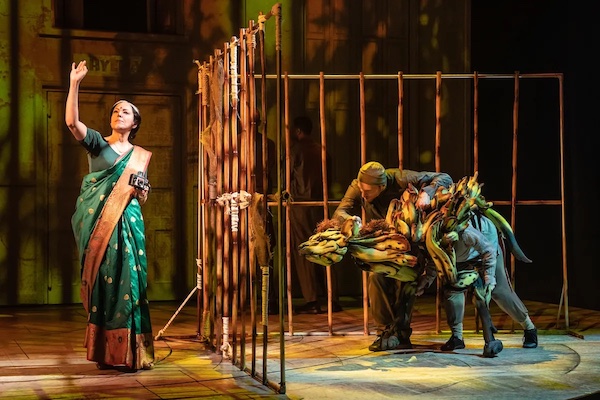Magic and Realism on Stage: Yann Martel’s ’Life of Pi’ Opens on Broadway to Spectacular Reviews
- With dazzling imagination and sublime control, the show’s cast and crew conjure a delirious, dynamic, highly pettable world, says a critic.

Yann Martel’s “Life of Pi,” a magical realism novel, captured the hearts of readers worldwide when it was released more than two decades ago. It continues to enchant in different forms — as Ang Lee’s Oscar-winning 2012 film and as a theatrical production in London’s West End. Now the five Olivier Awards winner including Best New Play, “Life of Pi” has made a roaring debut on Broadway’s Gerald Schoenfeld theater, after month-long previews.
Directed by Max Webster and adapted by the playwright Lolita Chakrabarti, the play based on a Booker Prize-winning novel opened on March 30 to spectacular reviews.

The New York Times said, “With dazzling imagination and sublime control, the show’s cast and crew conjure a delirious, dynamic, highly pettable world. And oh, is it a wonder. Though the play is ostensibly about one boy’s fraught survival after a disaster, that story is somewhat thin. “Life of Pi” instead succeeds as a broader tribute to human ingenuity and animal grace.”
The play features a stellar cast of 24 actors, many of them South Asians, with a Sri Lankan-born, British-trained actor, Hiran Abeysekera in the lead as Pi. He “is extraordinary as the central character of Pi; agile and expressive, he persuasively channels Pi’s distinctive mix of innocence, intelligence, unusual spirituality and mischievous wit,” wrote New York theater critic and journalist Jonathan Mandell.
Reviewing in Timeout, Adam Feldman says, “The impressive Abeysekera, who created the role of Pi in the West End, is a physically and emotionally agile actor, and his maturity—he is twice Pi’s age—helps give the character some of the gravitas missing from the script.”
There is a beautiful synchrony of lighting, video, sound and set. “Aided by the other production elements, the mise-en-scène constantly moves and shifts.”
The critics are particularly impressed by the stagecraft that includes special effects and some captivating puppets masquerading as animals. Writing in the Times, Alexis Soloski says, there is a beautiful synchrony of lighting, video, sound and set. “Aided by the other production elements, the mise-en-scène constantly moves and shifts,” she adds.
It is “a dazzling marvel of stagecraft filled with awe and joy,” declared” Entertainment Weekly. “Life of Pi is best when its fangs are visible,” noted Vulture magazine.
Elaborating on the technical marvels that went into the making of the play, Mandell says, “Whether or not his fantastical tale of sharing a lifeboat with a Bengal tiger for 227 days on the open seas will ‘make you believe in God,’ as the 17-year-old shipwreck survivor named Pi Patel promises, the stage adaptation of Yann Martel’s best-selling novel “Life of Pi” will give you faith in the power of puppetry and in the magic of stagecraft.”
“Life of Pi” is the story of a young Indian boy named Piscine Molitor Patel, known as Pi, who becomes stranded on a lifeboat in the Pacific Ocean with a Bengal tiger named Richard Parker. It explores the themes of survival, faith, and the power of storytelling.

The novel depicts the protagonist’s childhood in Pondicherry in southern India, where he grows up in a zoo owned by his family. His father is a rationalist who believes in science and reason, while his mother is a devout Hindu who embraces the beauty of spirituality. Pi, fascinated by religion, decides to practice three different religions: Hinduism, Christianity, and Islam, and becomes known as “Pi, the Pious.” However, his life is turned upside down when his family decides to sell the zoo and move to Canada.
During their voyage to Canada, the ship carrying Pi and his family sinks, leaving Pi as the only human survivor on a lifeboat with a zebra, a hyena, an orangutan, and the Bengal tiger named Richard Parker. Pi must learn to survive on the lifeboat while facing the challenges of living with a dangerous animal — a metaphor for the conflict-ridden societies we live in.
Lolita Chakrabarti, who adapted the novel to the stage is a British Indian actress and writer. She is a graduate of the Royal Academy of Dramatic Art.
Here’s the full list of cast and crew:
Written by Lolita Chakrabarti, based on the novel by Yann Martel.
Directed by Max Webster.
Set and Costume design by Tim Hatley, Puppet and Movement Direction by Finn Caldwell, Puppet Design by Nick Barnes and Finn Caldwell, Video Design by Andrzej Goulding, Lighting Design by Tim Lutkin, Sound Design by Carolyn Downing, Original Music by Andrew T Mackay, and Dramaturgy by Jack Bradley.
Cast: Hiran Abeysekera as Pi, Adi Dixit as alternate Pi, Brian Thomas Abraham as Cook and Voice of Richard Parker, Rajesh Bose as father, Nikki Calonge as Richard Parker, Machnaz Damania in ensemble, Fred Davis as Richard Parker, Avery Glymph as Father Martin, Russian sailor and Admiral Jackson, Jon Hoche in ensemble, Mahir Kakkar as nurse, Amma, and Orange Juice, Kirstin Louie as Lulu Chen, Rowan Ian Seamus Magee as Richard Parker, Jonathan David Martin as Richard Parker, Usman Ali Mughal in ensemble, Uma Paranjpe in ensemble, Salma Qarnain as Mrs. Biology Kumar and Saida Khan, Betsy Rosen as Richard Parker, Celia Mei Rubin as Richard Parker, David Shih in ensemble , Sathya Sridharan as Mamaji and Pandi-Ji, Daisuke Tsuji as Mr. Okamoto and Captain, Sonya Venugopal as Rani, Scarlet Wilderink as Richard Parker, Andrew Wilson as Richard Parker.


